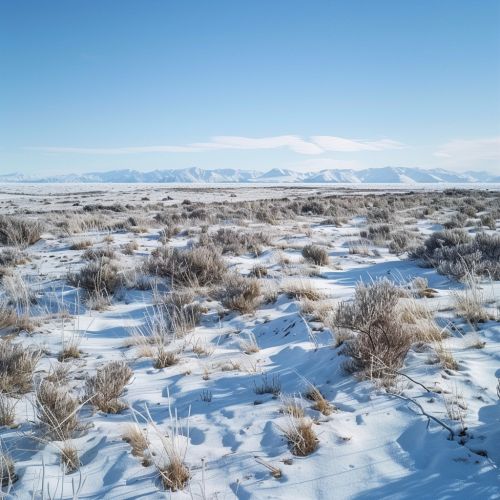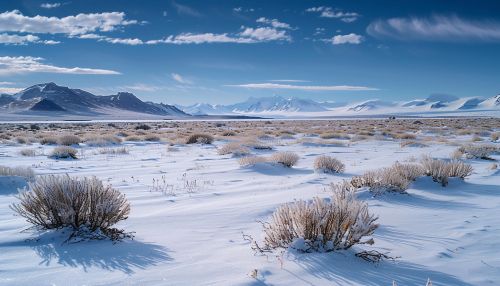Antarctic Tundra: Difference between revisions
(Created page with "== Introduction == The Antarctic Tundra, also known as the Antarctic Desert, is a unique biome characterized by its extreme cold, arid conditions, and limited biodiversity. Unlike the Arctic Tundra, which is located in the Northern Hemisphere, the Antarctic Tundra is situated on the continent of Antarctica and its surrounding islands. This article delves into the intricate details of this biome, exploring its climate, flora, fauna, and ecological significance. == C...") |
No edit summary |
||
| Line 51: | Line 51: | ||
* [[Convention for the Conservation of Antarctic Marine Living Resources]] | * [[Convention for the Conservation of Antarctic Marine Living Resources]] | ||
[[Image:Detail-92235.jpg|thumb|center|Landscape of the Antarctic Tundra with snow-covered ground, sparse vegetation, and distant mountains.|class=only_on_mobile]] | |||
[[Image:Detail-92236.jpg|thumb|center|Landscape of the Antarctic Tundra with snow-covered ground, sparse vegetation, and distant mountains.|class=only_on_desktop]] | |||
[[Category:Biomes]] | [[Category:Biomes]] | ||
[[Category:Antarctica]] | [[Category:Antarctica]] | ||
[[Category:Tundra]] | [[Category:Tundra]] | ||
Latest revision as of 14:01, 17 June 2024
Introduction
The Antarctic Tundra, also known as the Antarctic Desert, is a unique biome characterized by its extreme cold, arid conditions, and limited biodiversity. Unlike the Arctic Tundra, which is located in the Northern Hemisphere, the Antarctic Tundra is situated on the continent of Antarctica and its surrounding islands. This article delves into the intricate details of this biome, exploring its climate, flora, fauna, and ecological significance.
Climate
The climate of the Antarctic Tundra is one of the harshest on Earth. It is dominated by extremely low temperatures, strong katabatic winds, and minimal precipitation. The average temperature in the interior of Antarctica can drop below -60°C (-76°F) during the winter months, while coastal areas experience milder temperatures, averaging around -10°C (14°F) in the summer.
Precipitation in the Antarctic Tundra is scarce, with most areas receiving less than 200 mm (7.9 inches) of snow annually. This low level of precipitation classifies the region as a desert. The strong winds, often reaching speeds of over 100 km/h (62 mph), contribute to the harsh living conditions by increasing the wind chill factor and causing snow to drift, creating an ever-changing landscape.
Flora
The flora of the Antarctic Tundra is limited due to the extreme environmental conditions. Only a few hardy species of plants can survive in this biome. The primary vegetation consists of mosses, lichens, and algae. These plants have adapted to the cold and dry climate by developing mechanisms to conserve water and withstand freezing temperatures.
Mosses are the most common type of plant found in the Antarctic Tundra. They grow in small, dense clumps and can be found in moist areas, such as near melting snow or ice. Lichens, which are symbiotic associations between fungi and algae, are also prevalent. They can grow on rocks, soil, and even on other plants, and are capable of surviving long periods of desiccation.
Algae, including both freshwater and marine species, are found in various habitats across the Antarctic Tundra. Freshwater algae thrive in meltwater ponds and streams, while marine algae inhabit the coastal waters and sea ice.
Fauna
The fauna of the Antarctic Tundra is similarly limited, with only a few species adapted to the extreme conditions. The most well-known inhabitants are the penguins, particularly the Emperor Penguin and the Adélie Penguin. These flightless birds have evolved to survive the cold by developing thick layers of blubber and dense feathers for insulation.
Other bird species, such as the South Polar Skua and the Snow Petrel, also inhabit the region. These birds are highly adapted to the cold and rely on the abundant marine life for food.
Marine mammals, including seals and whales, are common in the coastal areas of the Antarctic Tundra. The most notable species are the Weddell Seal, the Leopard Seal, and the Humpback Whale. These animals have developed various adaptations to cope with the cold, such as thick blubber layers and specialized circulatory systems to maintain body heat.
Ecological Significance
The Antarctic Tundra plays a crucial role in the Earth's climate system. The ice and snow cover reflect a significant portion of the sun's radiation, helping to regulate global temperatures. The region also acts as a carbon sink, with the cold temperatures slowing down the decomposition of organic matter and trapping carbon in the ice and permafrost.
The unique ecosystem of the Antarctic Tundra provides valuable insights into the effects of climate change. As global temperatures rise, the ice and snow cover in Antarctica are melting at an unprecedented rate, leading to rising sea levels and changes in global weather patterns. Studying the Antarctic Tundra helps scientists understand these processes and develop strategies to mitigate the impacts of climate change.
Human Impact
Human activity in the Antarctic Tundra is limited due to the extreme conditions and international agreements aimed at preserving the region. The Antarctic Treaty System regulates human activities, ensuring that scientific research is conducted responsibly and that the environment is protected.
Despite these protections, human activities such as tourism, fishing, and scientific research can still impact the delicate ecosystem. The introduction of non-native species, pollution, and habitat disturbance are some of the potential threats to the Antarctic Tundra.
Conservation Efforts
Conservation efforts in the Antarctic Tundra focus on minimizing human impact and protecting the unique biodiversity of the region. The Convention for the Conservation of Antarctic Marine Living Resources (CCAMLR) is one of the key international agreements aimed at preserving the marine life and ecosystems of the Southern Ocean.
Research stations in Antarctica follow strict environmental protocols to minimize their footprint, including waste management practices, energy conservation, and measures to prevent the introduction of non-native species. Ongoing scientific research is essential for monitoring the health of the Antarctic Tundra and developing effective conservation strategies.
See Also
- Arctic Tundra
- Permafrost
- Katabatic Wind
- Antarctic Treaty System
- Convention for the Conservation of Antarctic Marine Living Resources


